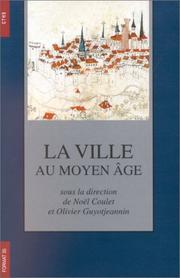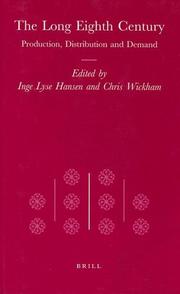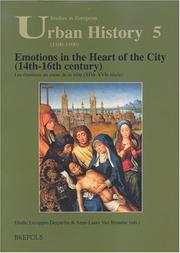| Listing 1 - 4 of 4 |
Sort by
|

ISBN: 9782735504220 2735504220 Year: 1999 Publisher: Paris Editions du CTHS
Abstract | Keywords | Export | Availability | Bookmark
 Loading...
Loading...Choose an application
- Reference Manager
- EndNote
- RefWorks (Direct export to RefWorks)
Cities and towns, Medieval - Congresses --- Cities and towns - Europe - History - To 1500 - Congresses. --- Urban geography - Europe - History - Congresses. --- Civilization, Medieval - Congresses --- Cities and towns, Medieval --- Cities and towns --- Urban geography --- Civilization, Medieval

ISBN: 9004117237 9004473459 9789004117235 9789004473454 Year: 2000 Volume: 11 Publisher: Leiden; Boston : BRILL
Abstract | Keywords | Export | Availability | Bookmark
 Loading...
Loading...Choose an application
- Reference Manager
- EndNote
- RefWorks (Direct export to RefWorks)
The eighth century has not been analysed as a period of economic history since the 1930s, and is ripe for a comprehensive reassessment. The twelve papers in this book range over the whole of Europe and the Mediterranean from Denmark to Palestine, covering Francia, Italy and Byzantium on the way. They examine regional economies and associated political structures, that is to say the whole network of production, exchange, and social relations in each area. They offer both authoritative overviews of current work and new and original work. As a whole, they show how the eighth century was the first century when the post-Roman world can clearly be seen to have emerged, in the regional economies of each part of Europe.
Cities and towns, Medieval --- Commerce --- Villes médiévales --- History --- Histoire --- Europe --- Economic conditions --- Conditions économiques --- Cities and towns --- -Commerce --- -Trade --- Economics --- Business --- Transportation --- Global cities --- Municipalities --- Towns --- Urban areas --- Urban systems --- Human settlements --- Sociology, Urban --- -History --- -Europe --- -Council of Europe countries --- Eastern Hemisphere --- Eurasia --- -Cities and towns --- -Economic conditions --- -Cities and towns, Medieval --- Villes médiévales --- Conditions économiques --- Cities and towns - Europe - History - To 1500. --- Commerce - History - Medieval, 500-1500. --- HISTOIRE UNIVERSELLE --- HISTOIRE ECONOMIQUE --- EMPIRE CAROLINGIEN --- EUROPE --- 08E SIECLE --- CONDITIONS ECONOMIQUES --- 04E-09E SIECLES
Book
ISBN: 2738112382 9782738112385 Year: 2003 Publisher: Paris : Odile Jacob,
Abstract | Keywords | Export | Availability | Bookmark
 Loading...
Loading...Choose an application
- Reference Manager
- EndNote
- RefWorks (Direct export to RefWorks)
Bruges, Francfort, Gênes, Rome ou Paris sont aussi représentatives du Moyen Age que la seigneurie, le fief, le servage et les expéditions des croisés. Au moment où il se clôt, la carte de l'Europe des villes coïncide avec celle des centres de culture et des lieux où se crée la richesse. La civilisation européenne est devenue vraiment urbaine.Thierry Dutour redonne vie au discours des contemporains sur leurs villes. Il montre comment le temps des villes épiscopales, jusqu'au IXe siècle, se distingue des siècles postérieurs. Il met en valeur l'urbanisation de l'Europe latine au Xe siècle. Il souligne le lien entre essor démographique, expansion agraire et prolifération des villes du VIIIe au XIVe siècle. Il décrit enfin la vie en ville, reflet d'évolutions sociales majeures.
Cities and towns, Medieval --- Urbanization --- Villes médiévales --- Urbanisation --- History --- Histoire --- Europe --- Social conditions --- Conditions sociales --- Cities and towns --- Sociology, Urban --- Middle Ages --- -Middle Ages --- -Sociology, Urban --- -Urbanization --- -Cities and towns, Movement to --- Urban development --- Urban systems --- Social history --- Sociology, Rural --- Urban policy --- Rural-urban migration --- Urban sociology --- Dark Ages --- History, Medieval --- Medieval history --- Medieval period --- World history, Medieval --- World history --- Civilization, Medieval --- Medievalism --- Renaissance --- Global cities --- Municipalities --- Towns --- Urban areas --- Human settlements --- -History --- Middle Ages. --- Urbanisme --- Europe de l'Ouest --- -Cities and towns --- Villes médiévales --- Cities and towns, Movement to --- Cities and towns - Europe - History - To 1500 --- Urbanization - Europe - History - To 1500 --- Sociology, Urban - Europe - History - To 1500

ISBN: 2503516181 9782503516189 9782503538815 Year: 2005 Volume: 5 Publisher: Turnhout : Brepols,
Abstract | Keywords | Export | Availability | Bookmark
 Loading...
Loading...Choose an application
- Reference Manager
- EndNote
- RefWorks (Direct export to RefWorks)
Whoever is curious about emotions and their expression in the Old Regime has to discover Johan Huizinga’s works. From his point of view, even if it is a real challenge to comprehend the world of the mind and of the sentimental life, historians of medieval and early modern societies cannot help themselves from examining character studies to reconcile daily life and historicity. Anglo-Saxon studies have proved since the beginning of the seventies that we can give historical meaning to fierce emotions like anger and fear, to mental suffering characterized by tears and pain, or even to the sudden feeling of aesthetic pleasure, mystical ecstasy and delight… all those emotions which put the breath of life into anonymous people crowded into our historical studies. Outside the debates of psycho-history, our study views the topic of emotions from the angle of social construction and civilization’s process.The town reveals itself as an ideal context within which to articulate values, mentalities, customs and aesthetics. From the marketplace to the court of justice, from the procession route to the scaffold, from the theatre stage to the scene of riots, the town concentrates in its heart a public space where both delicate and strong emotions are repeatedly enacted. The purpose of this book is to develop different approaches —according to sphere, events, social categories, social relations, gender, etc.— and thus to suggest a more precise analysis of emotion as a means of communication inside the town. Three urban social «spheres» where divergent emotions were publicly expressed, manipulated, discussed and represented are put into focus: that of the urban revolt, that of the urban administration of justice and that of the staging of urban theatre and poetry.
Cities and towns --- Emotions --- History --- History as a science --- History of civilization --- anno 1400-1499 --- anno 1500-1599 --- anno 1300-1399 --- Emotions--History--To 1500 --- Cities and towns--Europe--History--To 1500 --- Cities and towns--Europe--History--16th century --- Europe --- Cities and towns, Medieval --- Villes médiévales --- Villes --- Histoire --- Feelings --- Human emotions --- Passions --- Psychology --- Affect (Psychology) --- Affective neuroscience --- Apathy --- Pathognomy --- Council of Europe countries --- Eastern Hemisphere --- Eurasia --- Congresses --- 476-1492 --- 1492-1517 --- History. --- Emotions - History - Congresses --- Cities and towns - Europe - Congresses --- Europe - History - 476-1492 - Congresses --- Europe - History - 1492-1517 - Congresses --- EMOTIONS --- PASSIONS (PHILOSOPHIE) --- VIOLENCE URBAINE --- VILLES --- EUROPE --- CONGRES --- HISTOIRE
| Listing 1 - 4 of 4 |
Sort by
|

 Search
Search Feedback
Feedback About
About Help
Help News
News